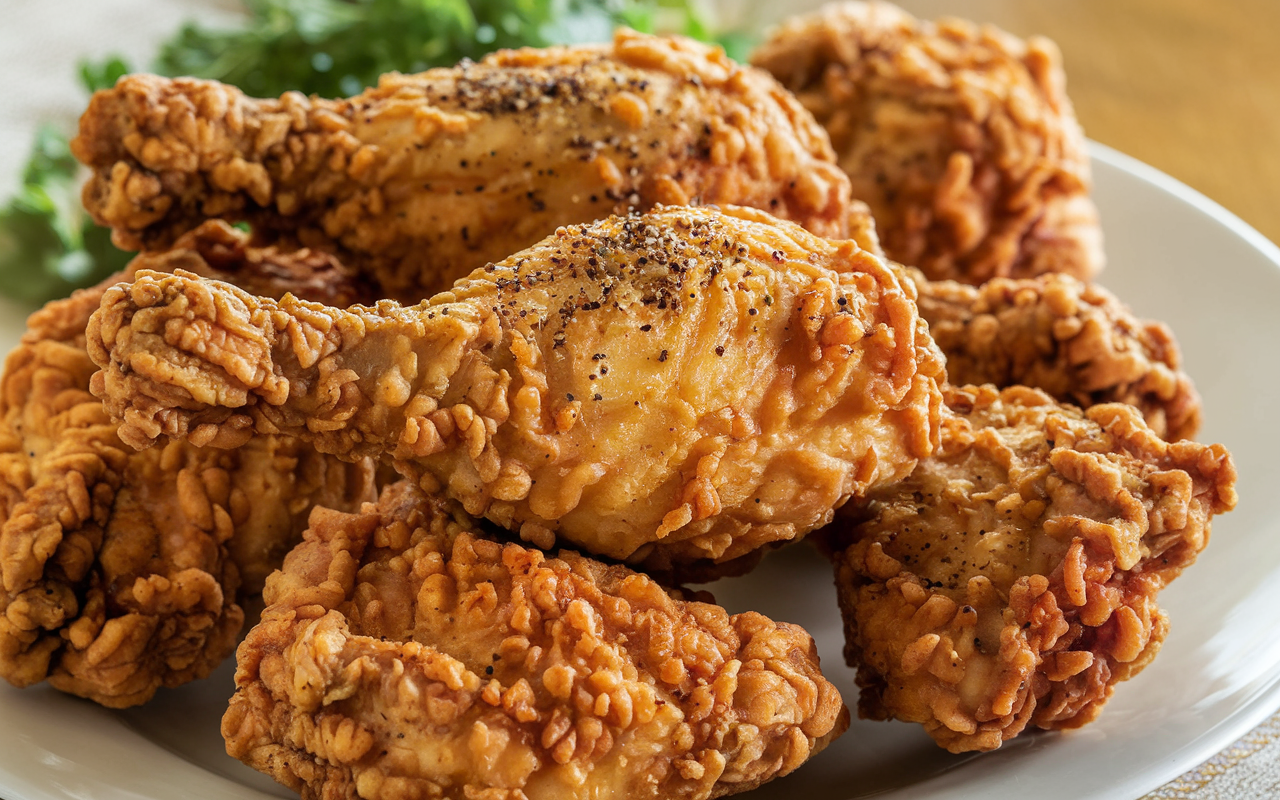Nothing brings back childhood memories quite like the aroma of fried chicken sizzling in the kitchen. This Grandma’s Fried Chicken Recipe is the ultimate Southern classic crispy, golden brown, and irresistibly juicy. Whether served with mashed potatoes, cornbread, or coleslaw, this dish captures the heart of old-fashioned home cooking. More than just a meal, fried chicken represents tradition, family gatherings, and the warmth of home-cooked love.
The tradition of fried chicken in America dates back generations, blending African, Scottish, and Southern influences into what we now know as the ultimate comfort food. Every grandma had her own special method some swore by an overnight buttermilk soak, while others added a pinch of cornstarch for that extra crunch. No matter the technique, the result was always the same: perfectly crispy, tender, and bursting with flavor.
Table of Contents
The History of the Recipe
The Origins of Fried Chicken
The origins of fried chicken can be traced back centuries, with influences from multiple cultures. While Scottish immigrants brought their tradition of deep-frying chicken without seasoning to America, West African cooking introduced the use of spices and flavorful marinades. Over time, these influences merged in the Southern United States, where fried chicken became a staple of soul food and Southern cuisine.
During the 18th and 19th centuries, fried chicken gained popularity in the American South due to its ability to be prepared in advance and eaten cold, making it ideal for long journeys and family gatherings. Unlike beef or pork, which required preservation methods, chicken was widely available and easy to cook. This accessibility helped cement fried chicken’s place in American homes and traditions.
By the early 20th century, fried chicken had become a symbol of Southern hospitality, served at Sunday dinners, church gatherings, and holiday celebrations. It wasn’t just a meal; it was an experience one that brought families together around the dinner table.
If you’re looking for the perfect side dishes to serve with fried chicken, try Grandma’s Mashed Potatoes for a comforting, homestyle meal.
The Tradition of Family Gatherings
In many households, fried chicken was a Sunday tradition. Grandmothers would wake up early, prepare the ingredients, and let the chicken soak in buttermilk for hours to tenderize it. The sizzling sound of chicken frying in a cast-iron skillet would fill the house, signaling that a delicious meal was on its way.
For many, the best part wasn’t just the taste, but the process watching grandma work her magic in the kitchen, hearing stories about the past, and sneaking a crispy bite before dinner. The family recipe was often passed down from generation to generation, with each cook adding their own special touch.
Pairing fried chicken with Southern Biscuits and Gravy or Grandma’s Cornbread Recipe can complete the traditional Southern meal experience.
Grandma’s Fried Chicken Recipe
Ingredients
- 4 bone-in, skin-on chicken thighs
- 4 drumsticks
- 2 cups buttermilk
- 1 tablespoon hot sauce (optional)
- 2 cups all-purpose flour
- 1 tablespoon cornstarch
- 1 teaspoon baking powder
- 1 tablespoon garlic powder
- 1 tablespoon onion powder
- 1 teaspoon paprika
- 1 teaspoon cayenne pepper (adjust to taste)
- 1 teaspoon salt
- 1 teaspoon black pepper
- 2 eggs
- 1/4 cup milk
- Vegetable oil for frying
Instructions
- Marinate the Chicken: Place the chicken pieces in a bowl and cover with buttermilk and hot sauce. Let it marinate in the fridge for at least 2 hours or overnight for the best flavor.
- Prepare the Coating: In a large bowl, whisk together flour, cornstarch, baking powder, garlic powder, onion powder, paprika, cayenne, salt, and black pepper.
- Egg Wash: In another bowl, beat eggs with milk.
- Coat the Chicken: Remove chicken from the buttermilk, letting excess drip off. Dip each piece into the seasoned flour, then into the egg mixture, and back into the flour mixture. Press the coating onto the chicken for a crispy texture.
- Heat the Oil: In a large skillet or deep fryer, heat about 2 inches of vegetable oil to 350°F (175°C).
- Fry the Chicken: Fry in batches, avoiding overcrowding. Cook for 7-10 minutes per side, or until golden brown and the internal temperature reaches 165°F (75°C).
- Drain and Serve: Remove from oil and place on a wire rack or paper towel to drain excess oil. Serve hot!

For a hearty meal, pair your fried chicken with Grandma’s Chicken and Dumplings Recipe for a taste of Southern comfort.
Grandma’s Tips and Variations
Family Secrets for Perfect Fried Chicken
- Let it marinate longer: The longer the chicken sits in buttermilk, the more tender and flavorful it will be.
- Use cornstarch for extra crunch: Adding cornstarch to the flour mixture helps create an ultra-crispy crust.
- Don’t overcrowd the pan: Frying too many pieces at once lowers the oil temperature, resulting in soggy chicken.
- Use a thermometer: Ensure the oil stays at 350°F for even cooking and crispy results.
- Rest on a wire rack: This prevents the bottom of the chicken from getting soggy while it cools.
Variations & Regional Twists
- Spicy Kick: Add extra cayenne pepper and a pinch of chili powder for a spicier version.
- Honey Butter Glaze: Drizzle the fried chicken with a mixture of honey and melted butter for a sweet touch.
- Nashville Hot Chicken: After frying, brush the chicken with a spicy oil mixture for a fiery Southern classic.
- Air Fryer Option: Coat the chicken lightly in oil and cook in an air fryer at 375°F for about 25 minutes, flipping halfway.
Conclusion
Fried chicken isn’t just a meal; it’s a connection to our past, a celebration of family, and a dish that brings comfort like no other. Whether it’s a Sunday dinner, a picnic, or a holiday feast, Grandma’s Fried Chicken remains a timeless favorite, passed down through generations.
Every bite carries the legacy of tradition, love, and the simple joys of home cooking. Now it’s your turn to try this classic recipe did your grandma have her own special trick? Share your family’s fried chicken memories in the comments below!

